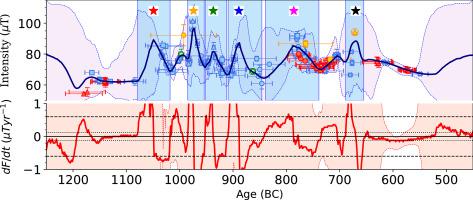Physics of the Earth and Planetary Interiors ( IF 2.3 ) Pub Date : 2021-02-04 , DOI: 10.1016/j.pepi.2021.106657 Philip W. Livermore , Yves Gallet , Alexandre Fournier

|
Observational records of rapidly varying magnetic fields strongly constrain our understanding of core flow dynamics and Earth's dynamo. Archeomagnetic analyses of densely sampled artefacts from the Near-East have suggested that the intensity variation during the first millennium BCE was punctuated with two geomagnetic spikes with rates of change of intensity exceeding 1 μT/yr, whose extreme behaviour is challenging to explain from a geodynamo perspective. By applying a new transdimensional Bayesian method designed to capture variations on both long and short timescales, we show that the data considered only at the fragment (thermal-unit) level require a complex intensity variation with no less than six spikes, each with an approximate duration of between 30 and 100 years. However, the nature of the inferred intensity evolution and the number of spikes detected are fragile and highly dependent on the specific treatment of the archeomagnetic data. No spikes are observed when the data are considered only at the level of a group of fragments from the same archeological context, with a minimum of three different artefacts per context. Furthermore, the number of spikes decreases to zero when increasing the error budget for the intensity at the fragment level within reasonable levels of 3–6 μT and the data age uncertainty up to 50 years. Of the six spikes found, the most resilient when increasing the error budget was dated at ~970 BCE. However, we show that even this spike sensitively depends on the age model proposed for data from the Levant archeological site Timna-30 and disappears when considering a single Gaussian age prior distribution for these data and a moderate minimum intensity error. Thus, depending on the choices made, the Near-Eastern data are compatible with a broad range of time-dependence, from six spikes at one extreme to zero spikes on the other. An error of 6 μT at the fragment level produces a spikeless model with strong similarity with the reconstruction from the SHAWQ-Iron Age global model with rates of change of ~0.2–0.3 μT/yr.
中文翻译:

黎凡特地磁峰值时期的地磁强度变化
迅速变化的磁场的观测记录极大地限制了我们对核心流动力学和地球发电机的理解。对近东密集采样的文物的考古磁学分析表明,在公元前一千年的第一年,强度变化被两个地磁峰值所打断,强度变化率超过1μT / yr,它的极端行为很难从大地发电机的角度来解释。通过应用旨在捕获长时和短时尺度变化的新的多维贝叶斯方法,我们表明,仅在片段(热单位)水平上考虑的数据需要复杂的强度变化,且不少于六个尖峰,每个尖峰具有近似持续时间在30到100年之间。但是,推断强度演变的性质和检测到的尖峰数量很脆弱,并且高度依赖于对地磁数据的特殊处理。当仅在来自同一考古背景的一组碎片的水平上考虑数据时,没有观察到峰值,每个背景至少有三个不同的人工制品。此外,μT和长达50年的数据年龄不确定性。在发现的六个峰值中,增加错误预算时最有弹性的发生在公元前970年。但是,我们表明,即使这个峰值也敏感地取决于针对黎凡特考古遗址Timna-30的数据提出的年龄模型,并且当考虑这些数据的单个高斯年龄先验分布以及中等最小强度误差时,这种消失就会消失。因此,根据做出的选择,近东数据与广泛的时间相关性兼容,从一个极端的六个尖峰到另一个极端的零尖峰。6错误μ T取代所述片段级别生成与从与〜0.2-0.3的变化率的SHAWQ-铁器时代全局模型重建强相似性的模型spikeless μ T /年。


























 京公网安备 11010802027423号
京公网安备 11010802027423号